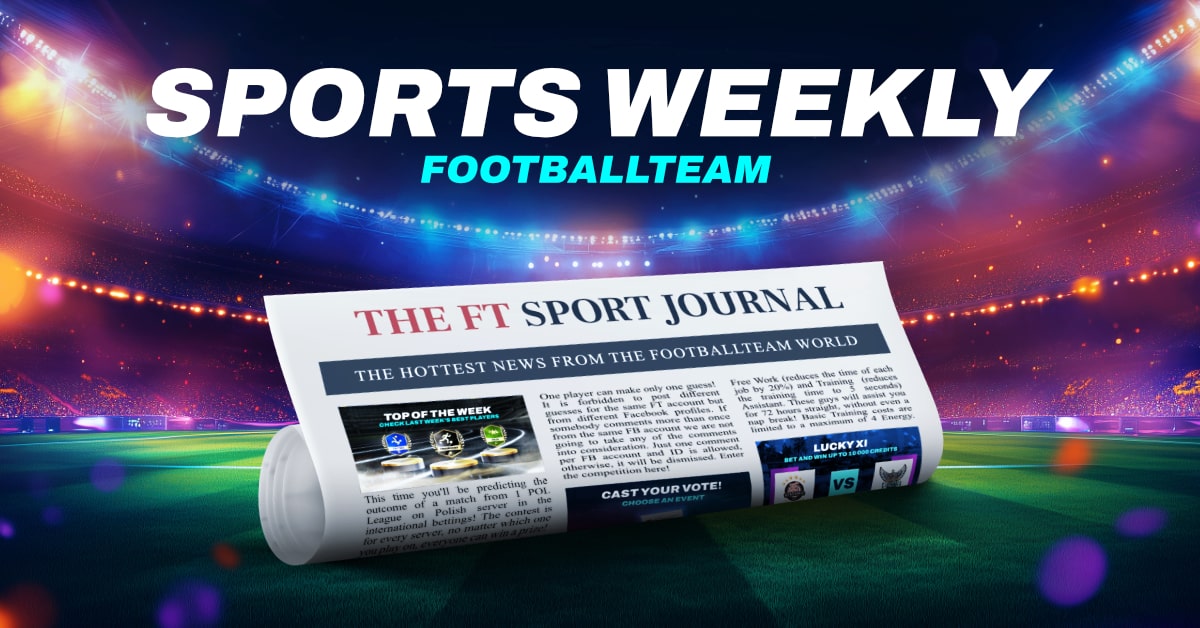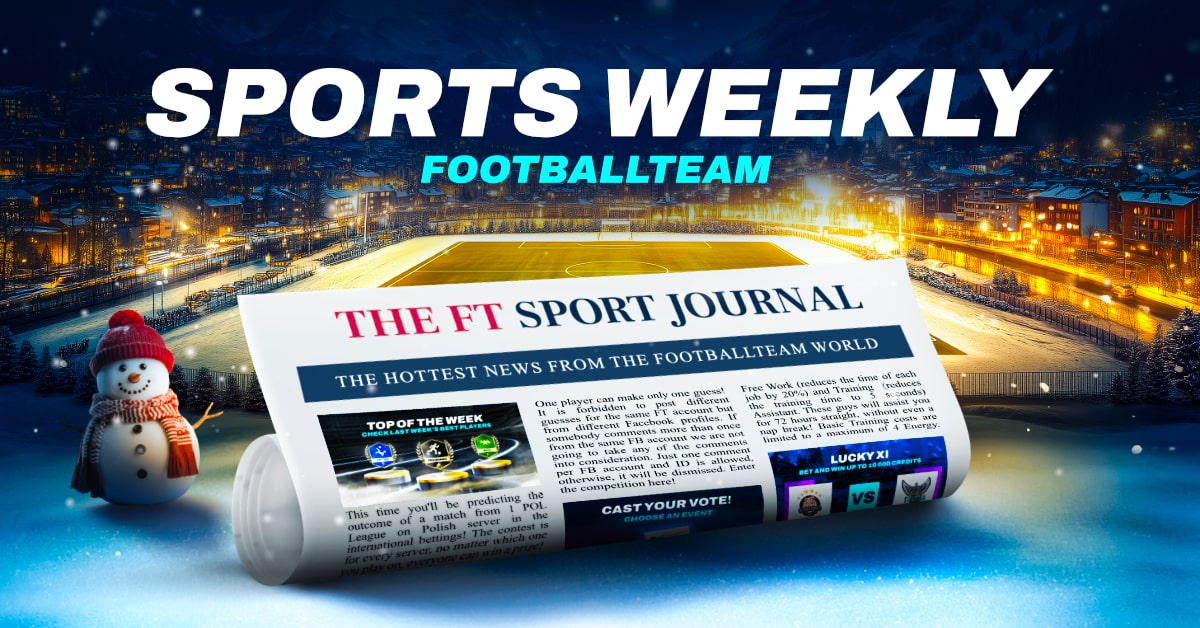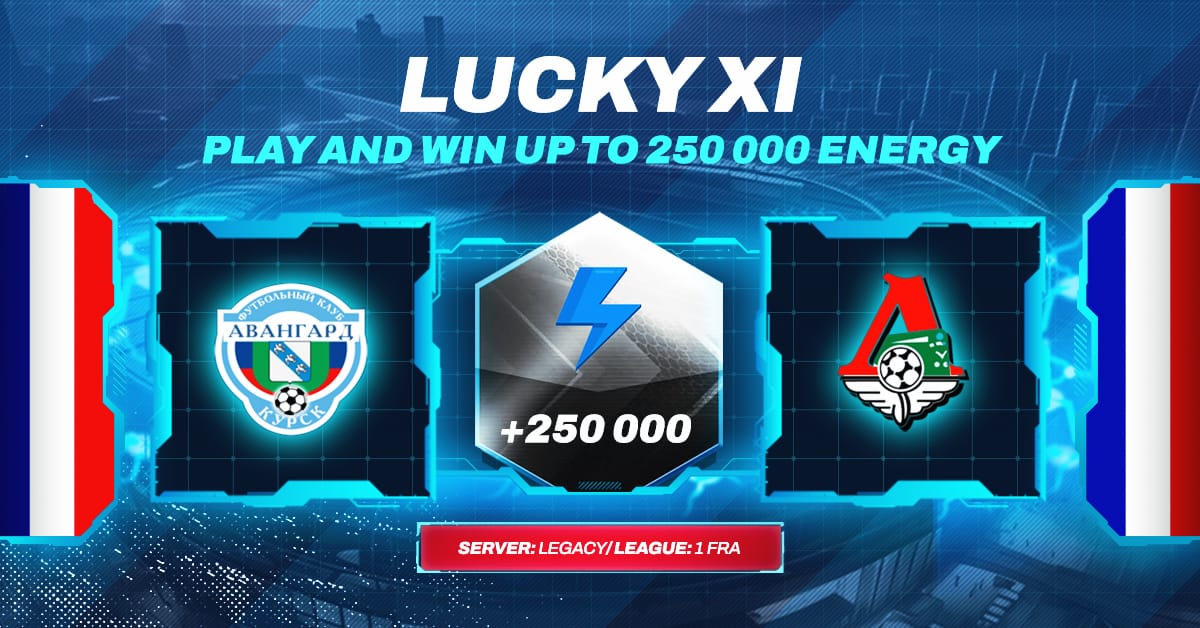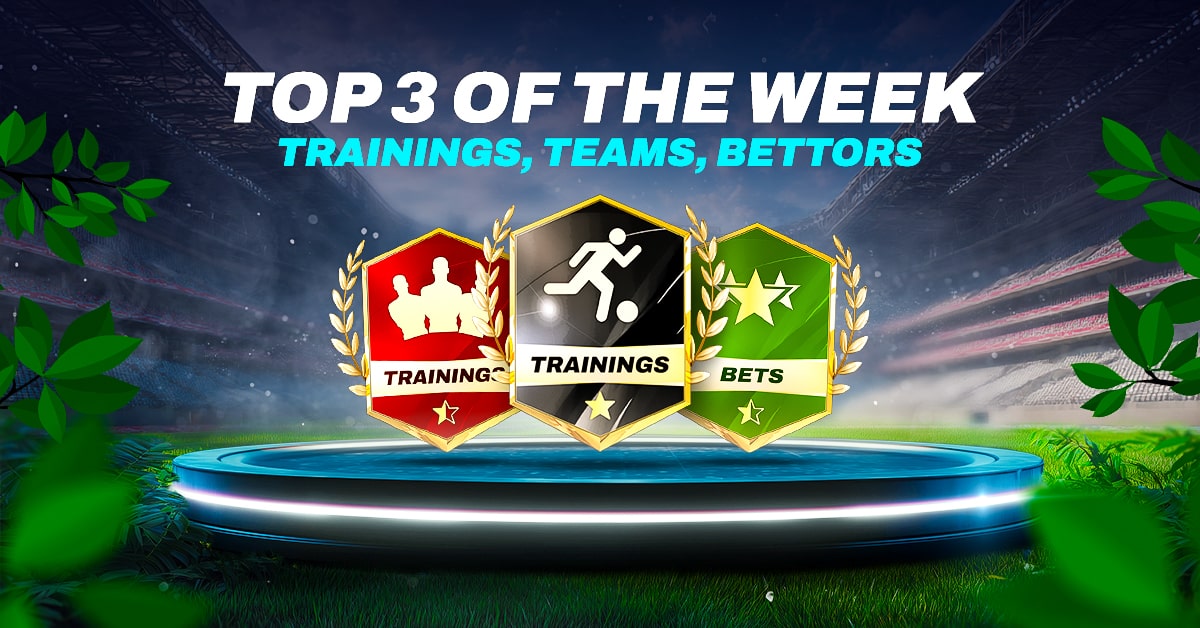The FT Sport Journal Legacy #8
19-09-2024




Your weekly source of information and entertainment, Sports Journal on server Legacy #8 brought to you by our journalists, is here! Remember to vote for your favorite article at the end! ☕
TABLE OF CONTENTS
1/ FOOTBALL FROM THE INSIDE – HOW DOES A FOOTBALL TEAM PREPARE FOR THE SEASON?
2/ PROFILES OF FOOTBALLTEAM GANGSTERS #5 ADI TYGRYS
3/ MODERN TECHNOLOGY IN SOCCER
FOOTBALL FROM THE INSIDE – HOW DOES A FOOTBALL TEAM PREPARE FOR THE SEASON?
Hello, in today’s article, I would like to present how football teams prepare for the start of the season. The following article is based on the preparations of the team I manage. I encourage you to read on!
First Assumption: The main goal set for the team is to maintain a stable position in the middle of the table. Preparations for the 2023/2024 football season will begin with the preparatory period starting on July 1, 2024, and ending on August 16, 2024. The Mazovian Football Association has scheduled 15 weekend matches for the autumn round and 15 weekend matches for the spring round, as there are 16 teams in this league. The first match of the autumn round is scheduled for August 17, 2024, and the last one for November 23, 2024. The first match of the spring round is scheduled for March 15, 2025, and the last one for June 20, 2025. The spring round will be preceded by a transitional period, which will last from November 21, 2024, to January 7, 2025. From January 8, 2025, the preparatory period for the spring round will begin and will last until March 15, 2025. The first match of the spring round is scheduled for March 15, 2025.
Second Assumption: From the above, it follows that the first competitive period lasts almost 4 months. After this, there is a transitional period with a rest phase lasting 2 months and 2 weeks, followed by a preparatory period of 2 months and 1 week preparing players for the second competitive round. After this time, the second competitive period begins, which is very important for achieving the set goal of securing a safe position.
The first important thing when planning a one-year training cycle is to divide the training cycle into 5 phases:
🔹First Preparatory Period,
🔹First Competitive Period, including training during the autumn round,
🔹Transitional Period after the autumn round, involving deliberate rest,
🔹Second Preparatory Period,
🔹Second Competitive Period, including training during the spring round.
This is the period directly after rest and recovery following the end of the season. In this phase, the main focus will be on preparing and adapting the players to higher training intensity later on. The first preparatory period will last 5 weeks. In the first week of this period, we will focus on exercises that improve endurance, strength, flexibility, and elasticity.
Building on the foundation laid in the first week of the preparatory period, the proper preparatory period will follow, lasting 4 weeks. This period should positively impact the improvement of our team’s condition. Therefore, it is assumed that:
🔹Endurance Training: During the preparatory period, all training should focus on interval training. This should closely mimic the structure of a match, including sprints, various running directions, deceleration, and acceleration. In recovery phases, there are ball-related activities such as juggling and light ball games;
🔹Strength Training: Gradually reduce the load of weight training in favor of exercises that generate maximum strength in the shortest time, as this type of training is very effective for developing power and dynamism in players. Maximum strength will serve as the basis for developing speed and dynamism;
🔹Speed Training: Include as many dynamic exercises as possible. Players’ sprints should be varied, such as running backwards for a few steps, jumping for headers, and quick sprints forward;
🔹Flexibility and Agility: In this phase, we should prepare the player to minimize the risk of injuries. A well-prepared player is essential;
🔹Tactical and Technical Training: Exercises aimed at technical and tactical development of players, based on their specific roles within the team’s organization.
Entering the competitive period, we must remain in continuous training to maintain and even improve the form achieved during the preparatory period. In this phase, we focus on eliminating mistakes made during competitive matches. A league match replaces endurance training, so we should focus on dynamics, speed, and anaerobic endurance.
The autumn round, during which there are 15 competitive matches, lasts 3 months. Training at the same level week after week can lead to player fatigue and increased risk of injury. Therefore, every 6 weeks, lighter training sessions will be organized so that players can rest and regenerate. For one week, training sessions will not include speed and strength training, which will be replaced by 2-3 aerobic sessions.
The transitional period after the autumn round is a time to rest from football, but it is important not to neglect physical activity. This is necessary to minimize the loss of condition and strength built in the previous periods. Various forms of physical activity, such as swimming, running, and cycling, can help maintain fitness and ease the return to training in the next preparatory period.
Thank you in advance for reading my article! If you like this topic or have ideas on what I could write about next, feel free to leave your suggestions in the comments. Cheers!
Author : Kiero DS
PROFILES OF FOOTBALLTEAM GANGSTERS #5 ADI TYGRYS
The people mentioned below are real. Some situations have been exaggerated or embellished, and the article is meant to be a caricature of the featured individuals. If you don't like the text, Adi might pay you a visit, and as he always says, he can take down anyone with "half a punch."
A short career history:
Adi is a very colorful figure in the world of FootballTeam, and anyone who has ever played with him can confirm that. He is known to many as Quadrado, the titular Adi Tygrys, Adi from Łódź, or the Bottomless Well. He’s been playing FootballTeam from the very beginning, and on the Polish server, he has won everything possible multiple times! He has also secured the most important titles on other servers. Adi is a loyal FootballTeam player, creating an account on every newly launched server! During his career, he has represented the colors of such powerhouses as CopaCabana, Elite Hunters, Dream State, or We Don’t Care. It’s also worth mentioning the Latin American server dominator, Killers, with whom Adi won countless titles.
Stories from Łódź:
Adi is an extremely positive person with a unique sense of humor, but those who have crossed him know that he is just as consistent in enforcing his decisions. We’ve heard stories where no one would want to be, yet Adi came out of them virtually unscathed. Once, on a pleasant evening, Adi went out to get a kebab, and six well-built guys blocked his way. Unfortunately for them, they didn’t realize who they were dealing with, and their numerical advantage was no advantage at all. Adi dealt with them quickly because he was in a hurry for his kebab. The only downside was that his jaw hurt a bit while chewing, as one of the opponents managed to hit him while Adi was using his other hand to live-report the incident to us in our group chat.
Another time, in our messenger group, Adi announced that he had been hit by a car. We were all slightly worried and asked him, "What happened? Are you okay?" Adi, without hesitation, said that the perpetrator would have to take the car to a car bodyworker. He himself went on to work so as not to be late.
The gangster in Germany:
Adi is currently building the might of our western neighbor, Germany. He is constructing skyscrapers one after another at a pace that would surely land him in the Guinness World Records. Once, he was working on the 12th floor, and cement needed to be carried up. While his co-workers were using the elevator to transport it, Adi was doing it twice as fast using the stairs. No one was surprised by this. Adi once showed us his first job using a forklift. Two trucks would arrive at noon for unloading. His two co-workers were busy with the first one, while Adi took care of the second. While his colleagues were still unloading the first truck, Adi had unloaded the second, packed it again, and unloaded it a second time.
Despite his gangster-like physique, Adi is an incredibly empathetic and emotional person. He always puts the team before himself (unless it’s about Szczur aka Hobbit). You can never get bored with him, and he has permanently introduced many phrases into our vocabulary, such as: "you can do it once," "ja gut and Szczur lost weight," "there’s no time," and "I’m from Łódź, no worries," as well as many, many more. His verbal sparring with Hobbit or Mateo is legendary, providing plenty of laughter.
Summary:
Adi isn’t your typical "gangster" though from his appearance, he certainly resembles one the most. He has numerous tattoos relating to various world cultures. He’s a history enthusiast, and he’s often told us how the pyramids were built in ancient times and how he would build them, significantly reducing construction time while improving quality.
There are still many stories that could be told about him, as each day brings a new one. Thanks to him, the DS chat or now the Emeryci chat on the global server is unique and irreplaceable. Adi is a one-of-a-kind person in the world of FootballTeam, and I wish everyone the chance to meet him. Playing with him brings so much more joy.
Thank you for reading my article, and see you next week! Have a great day, everyone (except Szczur)!
Autor: Bestia
MODERN TECHNOLOGY IN SOCCER
In recent years, soccer has been actively introducing modern technology to make the game fairer and more interesting for spectators. Some of the most notable innovations have been video assisted refereeing (VAR) systems and the use of GPS trackers.
Video Assisted Refereeing (VAR) system:
The VAR system was first used at the FIFA Confederations Cup in 2017. It allows referees to review controversial moments of the game using video replays. This helps to avoid mistakes and make the right decisions in difficult situations. In Russia, the VAR system was first used at the 2018 FIFA World Cup.
How does it work?
The VAR and AVAR referees sit in a separate room - together they review every moment - this is important. But they do not check the game moments, but the referee's decisions - this is also very important. They can only intervene in a few cases:
🔹goal / no goal;
🔹penalty / no penalty;
🔹direct red card (not a second yellow card or a caution - VAR does not consider them!);
🔹mistaken identity (when the referee kicks out or gives a warning to the wrong player).
Often the check is “silent”, i.e. the head referee is not even informed that he has done the right thing. If the on-field referee puts his finger to his ear, he communicates with the video assistant - in which case the game cannot continue because the VAR has started checking for infringements. If the referee shows the monitor sign, then either the original decision has been changed after review, or he intends to go to the monitor himself to examine the moment.
According to many experts, VAR significantly improves the quality of refereeing and reduces the number of errors. However, there are also critics of this system, who believe that it slows down the game and makes it less dynamic.
The main advantages of VAR are:
1. Reduction of referee errors.
2. Quicker decision making in controversial moments.
3. Increased fairness of the game.
Disadvantages of VAR:
1. Slows down the progress of the game.
2. Difficult to use for novice referees.
3. High cost of implementation and maintenance of the system.
Despite some shortcomings, VAR remains one of the most significant technologies in modern soccer.
Use of GPS trackers:
GPS trackers are used to track the movements of players on the field. They allow analyzing the athletes' physical activity, their speed, distance traveled and game efficiency. This data helps coaches to adjust the training process and develop an optimal strategy for the match.
Examples of GPS tracker applications:
1. Health monitoring: GPS tracker data can be used to assess a player's fitness and prevent injuries.
2. Tactical analysis: coaches can study players' routes and optimize team tactics.
3. Game performance evaluation: statistical data can be used to evaluate the contribution of each player to the match result.
Like any new technology, GPS tracking has its pros and cons. The main advantages include increased accuracy in analyzing game activity and reduced risk of injury. The disadvantages include the high cost of the equipment and the difficulty in interpreting the data for beginners.
VAR and GPS-tracking technologies are important elements of modern soccer. Their implementation helps to improve the quality of the game and creates new opportunities for analyzing and improving sports training.
Author: Zidane
SPORTS MEDICINE
Hello players, let's talk a little about medicine and psychology applied to football.
Origins: In the early days of football, injuries were treated in a very rudimentary manner. Sports medicine, as we know it today, did not exist, and the focus was more on general recovery than on specific care for athletes.
1940s: Sports medicine developed more intensely in Italy and Germany from the 1940s onwards. In Germany, physiology was the most developed area, while in Italy, cardiological aspects were more valued.
1970s and 80s: Sports medicine became established as a specialty, and football began to have dedicated medical teams. It was a time of great advances in diagnostics, such as the use of imaging tests (X-rays, MRI) to assess injuries.
1990s and 2000s: The focus began to expand to the general health of players, including nutrition, psychology and specific training. Medical teams now include professionals from a variety of fields, such as nutritionists, psychologists and physical trainers.
Current: Sports medicine in football is highly specialised, with advanced technologies to monitor the health and performance of players. There is a significant emphasis on injury prevention, rapid rehabilitation and improving performance through detailed data and analysis.
The equipment used in the recovery of football players has evolved significantly, and is now highly technological and varied. Here are some of the main ones:
Cryotherapy Chambers:
Cryotherapy involves exposing the body to extremely low temperatures, usually between -100°C and -150°C, for a few minutes.
Hyperbaric Chambers:
The athlete breathes pure oxygen in a chamber with increased pressure, which accelerates the healing of damaged tissue and reduces recovery time from injuries.
Muscle Electrostimulation:
Muscle electrostimulation devices use low-intensity electrical currents to stimulate muscles.
NormaTec (Pneumatic Compression Therapy):
This equipment uses sequential compression chambers to improve blood flow in the legs and arms.
Kinesio Taping:
Elastic adhesive bandages applied to muscles and joints.
Therapeutic Ultrasound:
Equipment that uses ultrasound waves to heat deep tissue in the body.
Low Level Laser Therapy (LLLT):
Using low-level laser light to stimulate cellular recovery.
Movement Analysis Equipment (Biomechanics):
Equipment such as 3D cameras and force plates are used to analyze the athlete's movement.
Recovery Boots:
Portable compression equipment worn on the legs to improve blood flow.
Performance and Fatigue Monitoring Technology:
Devices such as GPS, accelerometers and heart rate monitors are used to track athletes’ training load and fatigue.
🧠Psychology
Psychology in football is crucial to improving players’ performance, helping them deal with pressure, anxiety, stress and maintain concentration. Sports psychologists work with techniques such as visualisation, emotional control, motivation and leadership development. They also help with mental recovery after injuries and moments of adversity, building resilience and promoting teamwork. The main focus is to balance mental and physical health, optimising both the well-being of athletes and their performance on the field. Key aspects of psychology in football:
1. Anxiety and Stress Management,
2. Motivation,
3. Teamwork and Communication,
4. Concentration and Focus,
5.Overcoming Injuries,
6. Mental Preparation,
7. Leadership and Self-Efficacy,
8. Emotion Management,
9. Growth Mindset,
10. Resilience.
See you next week!
Author: Fábio Muri
GREAT FOOTBALL STORIES
Hello players, how are you?
Here is another article for you, covering interesting stories about world football figures.
Messi and his transformation
The Argentine star was born on June 24, 1987 in Rosario, Santa Fe, and began his career at Newell’s Old Boys at the age of six. Messi has faced great challenges since childhood. After being diagnosed with a growth hormone deficiency, he had to undergo expensive treatments, which almost ended his football career.
The GH treatment is done through daily injections, applied at bedtime, subcutaneously in the thighs, arms, buttocks and abdomen. According to medical data, Messi needed more than 2,000 injections while he was being treated for the condition. Today he is 1.69m tall and it is not known if he would have reached this height without the treatment.
Drogba and the rebels
In 2007, Ivorian footballer Didier Drogba played for the Ivory Coast national team, despite also having French citizenship.
That year, his country was competing in the African Cup of Nations and was suffering five years of a bloody civil war, between the north controlled by rebels led by Guillaume Kigbafori Soro, and the established government regime of Laurent Koudou Gbagbo, who controlled the south of the country.
Ivory Coast was to face Madagascar at home, and Drogba publicly demanded that the game should be played at the Bouaké Stadium in Bouaké, the city where the rebel troops were based.
A ceasefire was agreed between Gbagbo and Soro, who watched the game side by side. A rebel tank escorted the team to the field. The game ended 5-0 for the home team and began peace talks. The rivals shook hands and decided, shortly after, to end the conflict. Guillaume Kigbafori Soro was the country's prime minister until 2020.
Football and celebration of indigenous peoples
The National Championship of Indigenous Peoples, in Chile, has been held since 2012. The participants are teams of ancestral peoples from South America, such as the Rapa Nui, Quechua and Mapuche. Eight teams participated in the last edition, which aimed to recognize and unite the Andean peoples.
In the Brazilian Amazon, football matches and competitions are held in indigenous communities such as the Kaiowá, Guarani, Bororo, Pataxó and Yanomami. The teams travel for days along the Amazon rivers to the host cities, in games that are scheduled during the dry season, when the fields are not flooded. The tournament's motto is: “The important thing is not to compete, but to celebrate”.
The Andean peasant women (Mamachas, in Peru and Cholitas, in Bolivia) have fun playing the sport in the middle of the plantations, on the top of the mountains or in the fields of the poorest communities. Dressed in traditional regional clothing. No shorts or T-shirts.
President Weah
As a footballer, he enjoyed the peak of his career playing for Milan between 1995 and 2000. In 1995, he was elected the first non-European footballer to receive the FIFA World Player of the Year award and the Ballon d'Or from France Football, and was the only African to receive both awards.
Through the George Weah Foundation, he helped victims of the First and Second Liberian Civil Wars.
He ran twice for the presidency of Liberia, losing in 2005 and again in the 2017 elections, being elected president of Liberia after defeating then vice-president Joseph Boakai.
The Honeyball woman
History has it that the first official women's football match was played on March 23, 1895 in London, England.
A woman ahead of her time, Nettie Honeyball, the captain of the North, was on the winning team in that match. In addition to being a player, she was the founder of the British Ladies Football Club, the organisation that organised the match and the first known women's football club.
Thanks and see you next time!
Author: Fábio Muri
Latest news

The Sports Journal #59

LUCKY XI PLAY AND WIN #340

Leave comment
Users must be logged in to comment.
9 Comments